Introduction
Methodological developments in workplace discourse
- Types of Discourse
- Sociolinguistic Perspectives in Workplace Discourse
- Conclusion
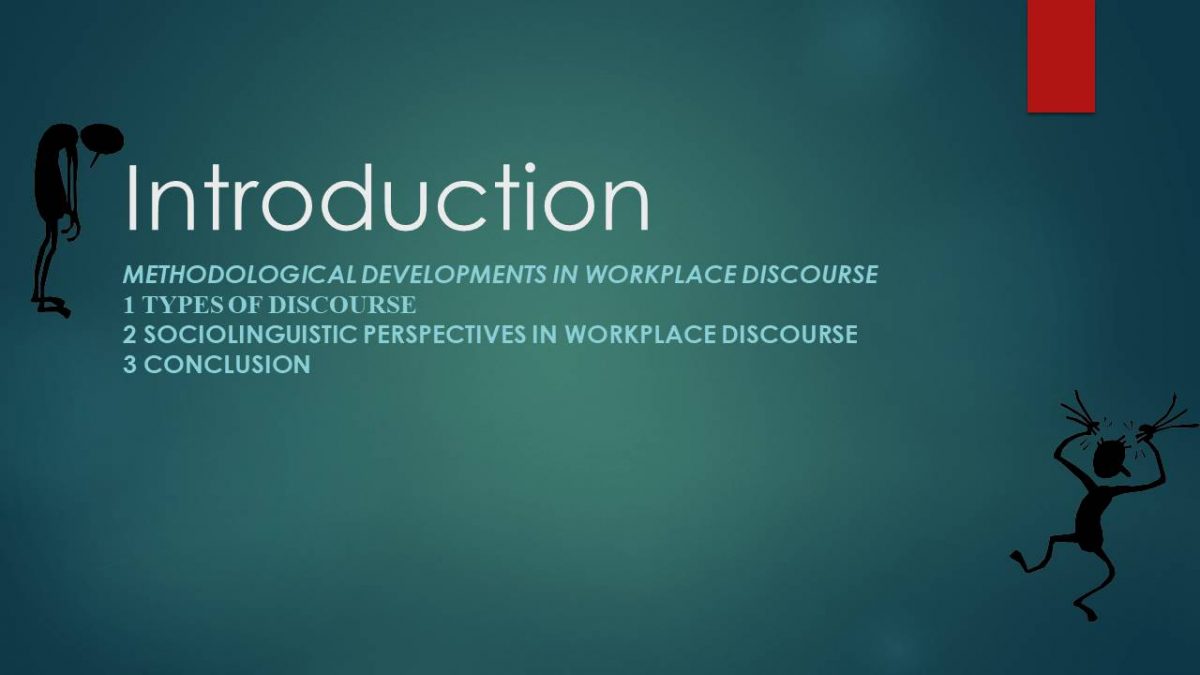
Discourse in the Workplace
Focus of early workplace discourses
- Institutional settings
- Analysis of the audio-recorded data
The earliest workplace discourse studies focused on talk in institutional settings, with interviews as a preferred genre, and the analysis of the audio-recorded data was dominated by Conversation Analysis (CA) practitioners such as those in the seminal collection edited by Drew and Heritage (1992).
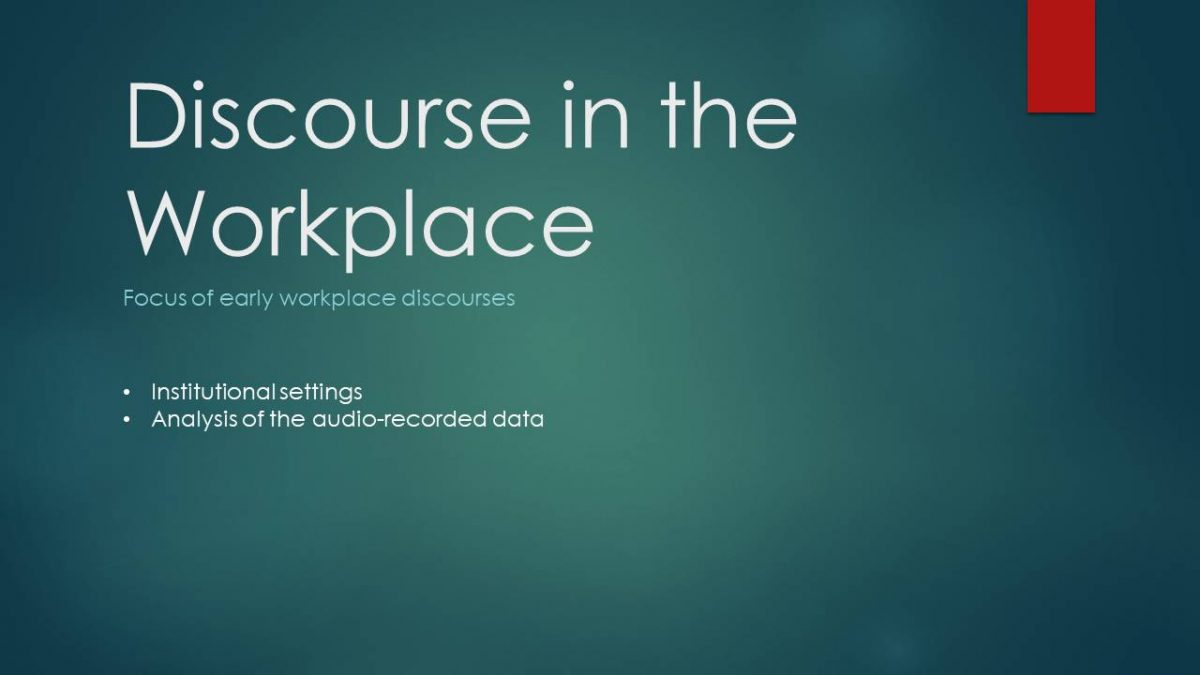
Recent research
- Ethnographic observation
- Video recording
- Written materials
- Locations which extend from factories and building sites to offices and boardrooms
- Studies of monolingual, multilingual, and multicultural employment sites.
- More recent research has extended data collection techniques to include ethnographic observation as well as video recording and written materials; and researchers’ interests now encompass a wide range of types of workplace discourse, as well as locations which extend from factories and building sites to offices and boardrooms.
- More recent workplace discourse research also includes studies of monolingual, multilingual, and multicultural employment sites.
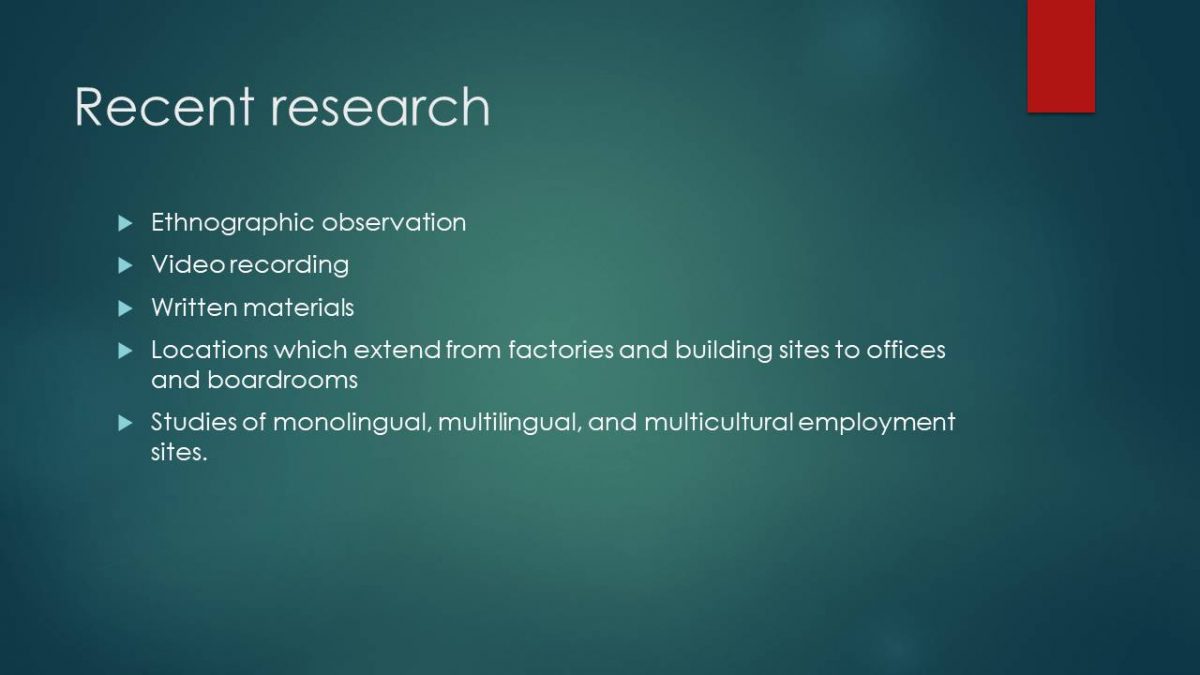
Developments in the area of workplace discourse from three different perspectives
- Ways in which methods of data collection and analysis have expanded over the last two decades
- A range of different types of work- place discourse which have been the focus of analysis are reviewed
- Identify insights gained from the particular perspectives which different researchers have taken in their examination of workplace discourse
I first discuss ways in which methods of data collection and analysis have expanded over the last two decades; second, a range of different types of work- place discourse which have been the focus of analysis are reviewed; third, I identify insights gained from the particular perspectives which different researchers have taken in their examination of workplace discourse. A theme that runs through the review is the pervasive evidence of cultural hegemony and the salience of power relations in workplace discourse research.
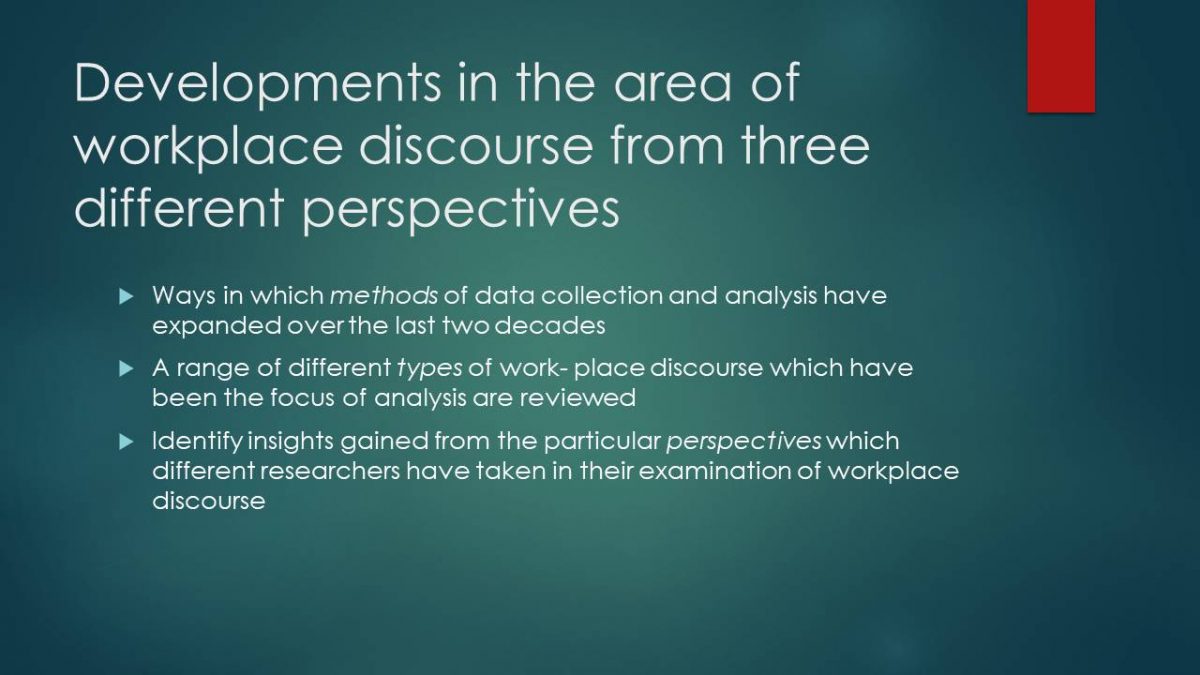
Methodological developments in workplace discourse
Methods currently in use to study spoken interaction in the workplace
- Interviews
- Non-participant observation
- Participant observation with varying degrees of ethnographic detail supplementing the observations
- Focus groups
- Audio-recording
- Shadowing
- Video recording
The range of methods currently in use to study spoken interaction in the workplace include interviews, non-participant observation, participant observation with varying degrees of ethnographic detail supplementing the observations, focus groups ,audio-recording with and without the researcher present ,shadowing, and video recording.
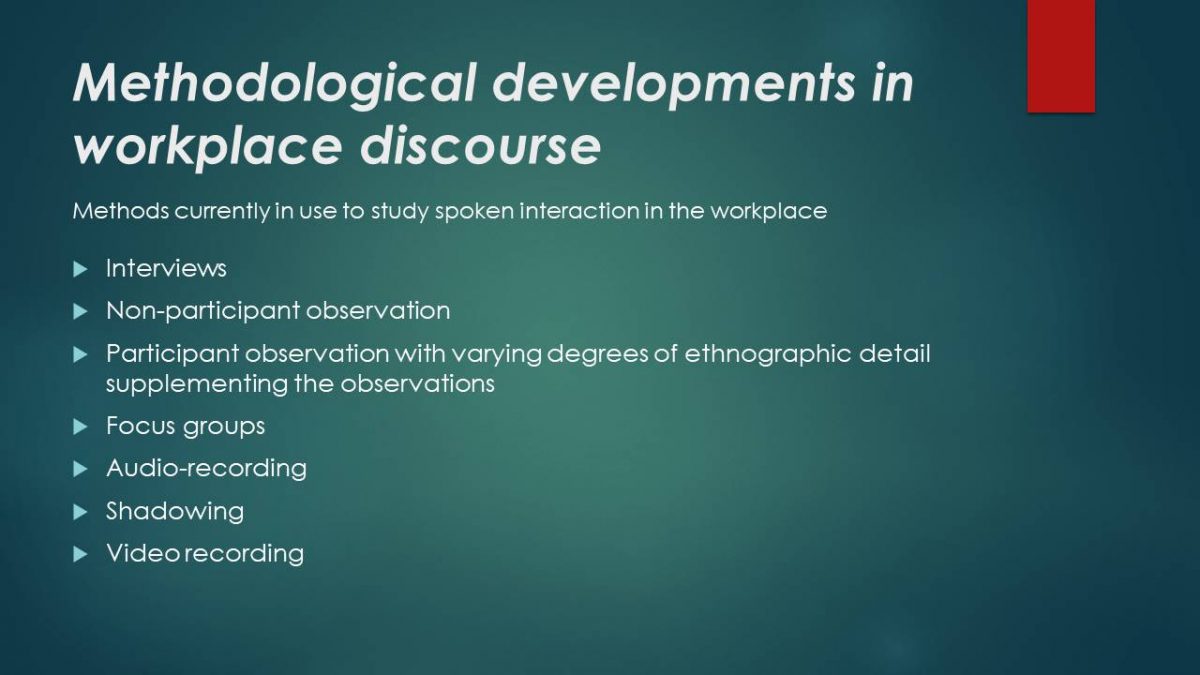
Methods of analysis
- Qualitative analysis
- Conversation Analysis (CA)
- Corpus analysis
CA approaches dominated research on institutional discourse in particular, and CA continues to make a strong contribution.
Corpus analysis is increasingly being used by those researching workplace discourse to identify frequent keywords, collocations, and chunks combined with qualitative analysis, to identify frequencies of different realizations of pragmatic functions, such as expressing opinions.
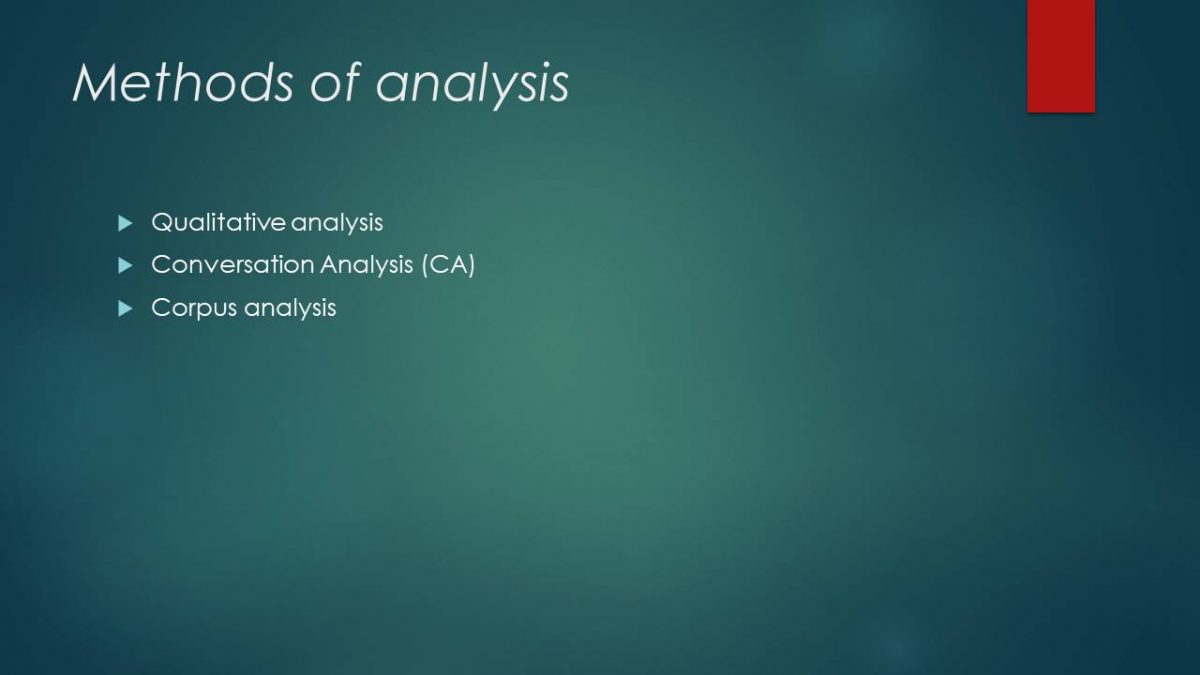
Types of Discourse (spoken discourse )
- Interviews
- Meetings, both small and large
- Small talk,
- Humour, and
- Narrative
- Email interaction
- Workplace notes and memos
The heading “types of discourse” here includes examples of what others might label discourse genres and fields. While interviews have long been a popular focus for work- place discourse analysis, meetings, both small and large, have attracted increasing attention in recent years. Other types of spoken discourse which have been analysed by different researchers include small talk, humour, and narrative. Researchers analysing written discourse have examined email interaction (e.g., de Oliveira 2011), workplace notes and memos, minutes of meetings and formal letters ,mission statements and website materials .
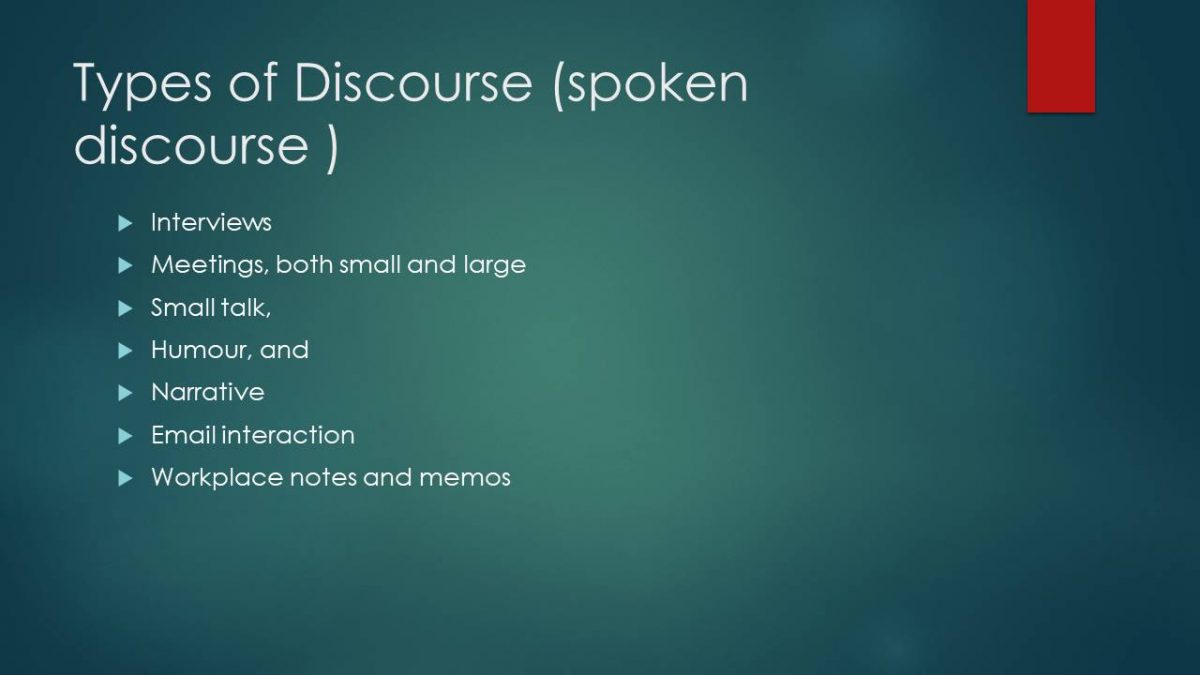
Interviews
- Job interviews
- Status and
- Gendered discourse norms
Job interviews have also been the focus of discourse analysis. An observation of video-recorded 48 Canadian job interviews, identifying discursive evidence of how trust and distrust were co-constructed between the participants, and demonstrating the significance of these concepts in accounting for candidates’ success or failure.
in formal interviews, both male interviewers and male interviewees were more likely to adopt a dominant interactional style with more initiations and more interruptions than females in the same status positions. In all this research, the dimension of power is thus very salient, as researchers examine the range of ways in which control of the interaction is exercised by different participants.

Meetings
- Meeting management
- Decision-making
- Problem-solving
Workplace meetings are an obvious site for enacting institutional power, as well as for maintaining and developing collegial relationships and doing “rapport management”. Meetings are also a promising site for examining manifestations of gendered behaviour.
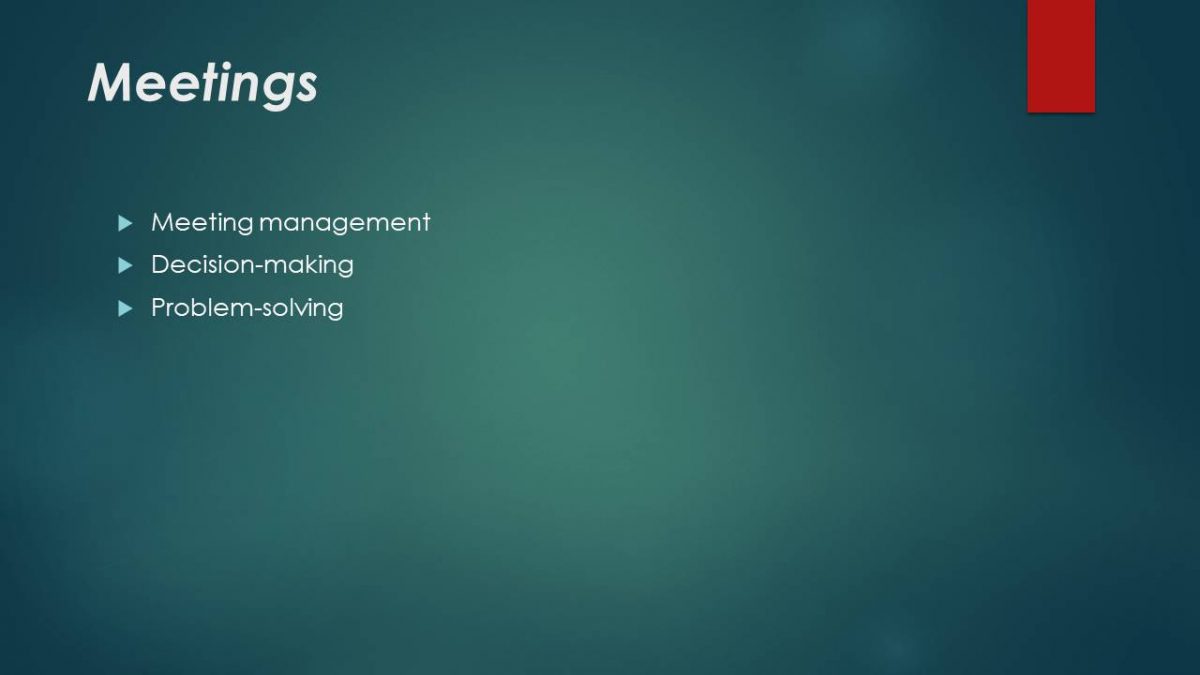
Manifestation of power in meetings
- Disruptive interruption
- Amount of talk contributed by different participants
- Use of questions to control the interaction and enact power
- Nonprimary” speaker to claim power
In addition to features of meeting organization, such as agenda management and topic control, discourse analysts have identified a range of very specific strategies through which power is manifested in meetings, including disruptive interruption (e.g., Craig and Pitts 1990), the amount of talk contributed by different participants and, as in interviews, the use of questions to control the interaction and enact power, or as a “nonprimary” speaker to claim power.
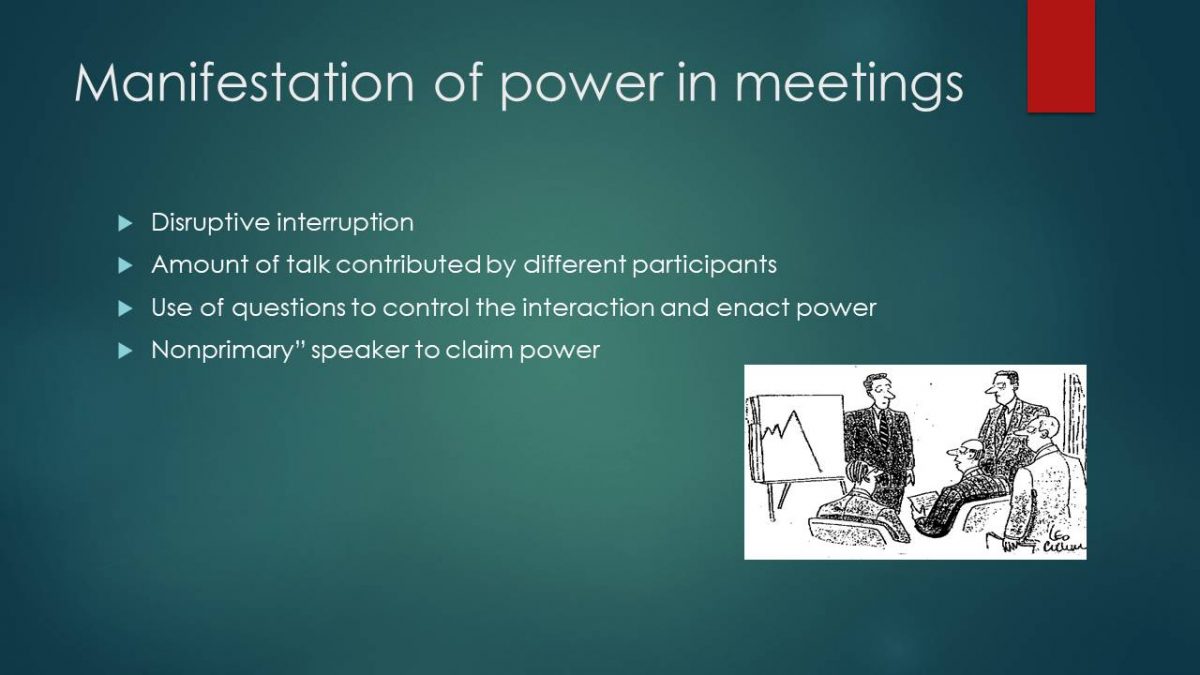
Example to show the manifestation of power in an interaction
Context: Management meeting in New Zealand company. The topic is the purchase of new photocopiers
Seamus: we were talking about buying a photocopier
Tom: we are buying it ( ) oh we have bought one
Seamus: you have bought one?
Tom: yep
Seamus: okay it’s about fourteen wasn’t it?
Tom: are we leasing it or are we buying it?
Seamus: I don’t know you and Deb sorted that out
Tom: has that deal been done?
Seamus: pretty much //( )\
Tom: /okay so\\ is it a programmable photocopier?
Seamus: does it have?
Tom: yeah
Seamus: okay so it’s got a movable back gauge and all of that?
Tom: yeah
Seamus: okay how physically big is it?
Tom: oh it wouldn’t be more than a metre square
Seamus: and how much did it cost?
Tom: probably about I thought I thought it was about twelve
In this brief example, Seamus asks eight of the nine questions, and they progress structurally from requests for confirmation of information that he wants verified to requests for new information; the questions also become increasingly demanding of the addressee. It is quite evident that even in this exchange about a routine matter, Seamus, the boss, controls the topic and the development of the discourse, despite the fact that he is not the meeting chair.

Small talk and humour
- Peripheral and sometimes disruptive activities which interfere with the core business of the workplace
- Cultural differences in the way humor is used and perceived in workplaces have also been documented
- Role of humor in integrating a new person into a workplace team or community of practice
- Both small talk and humor tend to occur at the margins of core workplace interaction: at the beginning and end of the day, at work breaks, at the beginning and ends of meetings as well as at the boundaries of topics or agenda items
- The person with most status typically initiated the humor in the Japanese meetings she analyzed, while in the New Zealand meetings analyzed by Holmes et al. (2003) the proportion of humor initiated by the chair ranged from 9 per- cent to 73 percent, and humor was also initiated by other participants.
- Meetings in government departments tended to use less humor, and less contestive humor, than meetings in commercial organizations.
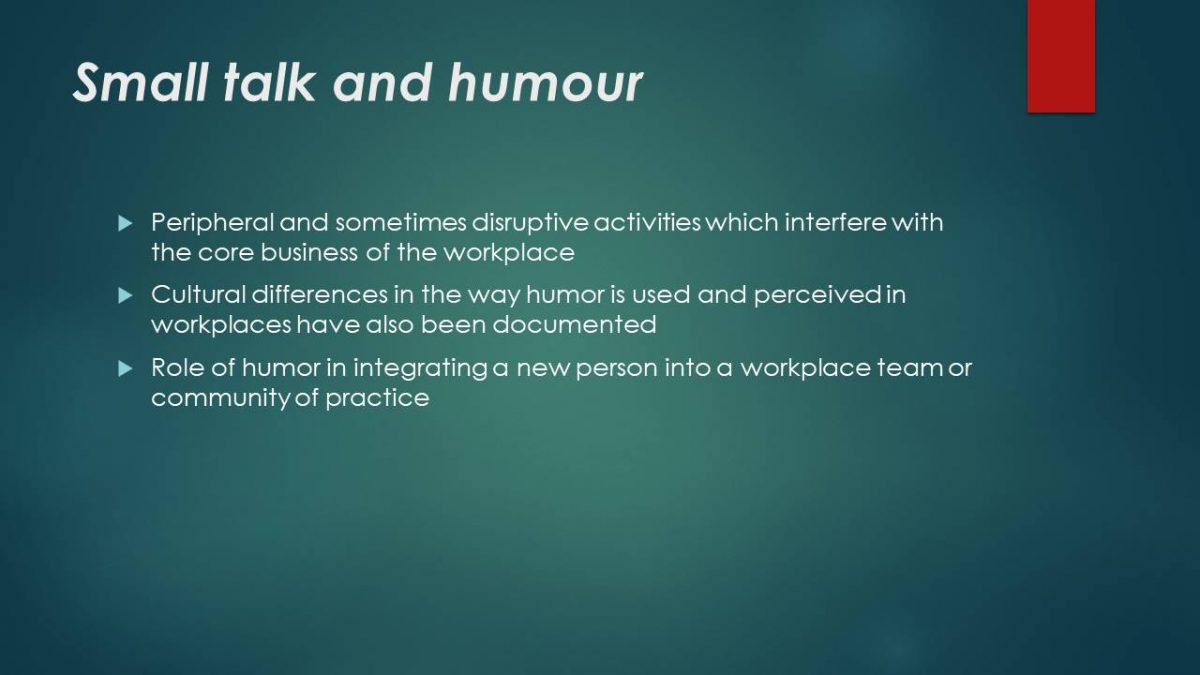
Sociolinguistic Perspectives in Workplace Discourse
Gender and workplace discourse
- Occupations
- Types of workplace interaction
- Workplace roles and Identities
- work- place contexts
Female and male, typically draw from a wide and varied discursive repertoire, ranging from normatively “feminine” to normatively “masculine” ways of talking.
Any particular utterance may thus be analyzed as contributing simultaneously to the construction of more than one aspect of an individual’s identity, whether social (enacting gender identity), institutional (their professional identity as a manager), or personal (their wish to be considered friendly, well-informed, and so on).
Most research on gendered styles has examined white-collar, professional interaction. Types of workplace discourse range from job interviews, through commercial transactions, and on-the-job encounters with clients, patients, and the general public, to workplace meetings of all sizes and kinds. Analyses tend to focus on different kinds of gendered behavior (e.g., flirtation, flattery, ribald banter, swearing), or ways in which gender identity is constructed in different types of interaction. Swearing, like verbal sexual harassment, for instance, is characterized as normatively masculine verbal behavior with negative consequences for women in some workplaces. Workplace humor can provide effective cover for harassment which places women in a double bind, unable to respond without loss of respect, yet risking condemnation or punishment if they do.
Based on roles and identities women leaders are perceived as deviant exceptions to the male norm.

Process of becoming a skilled or professional worker
- Discursive trajectory from apprentice to professional
- Peripheral or marginal (and sometimes migrant) status to integrated professional
- The process of becoming a skilled or professional worker involves discursive trajectory from apprentice to professional
- Peripheral or marginal (and sometimes migrant) status to integrated professional.

Gendered” workplace context
- People are very willing to identify some workplaces as particularly “feminine” and others as more “masculine.”
- Istinctive communicative patterns which tend to characterize different workplaces
- Through their on-the-job talk which involves swearing and violence, British builders construct building sites as masculine workplaces: “these Polish blokes they got guns an knives an they jus (.) they don’t think nothing of slittin ’someone’s throat”
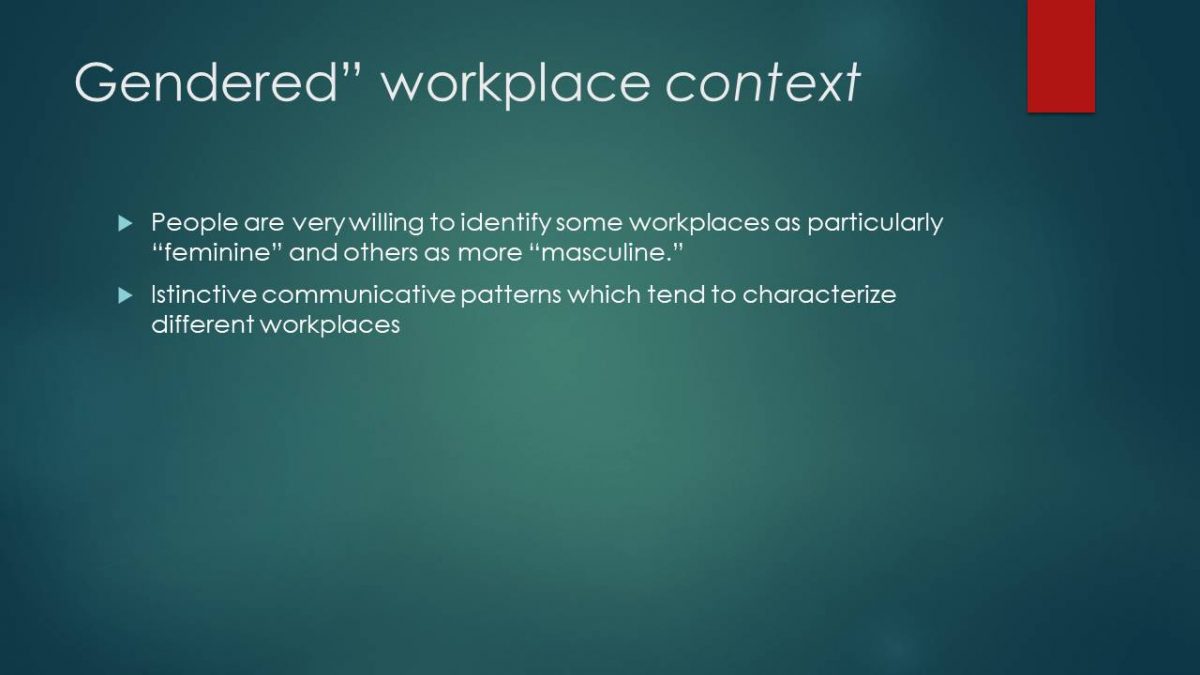
Ethnicity and workplace discourse
- Construction of ethnic identity in the workplace has not attracted as much attention as gender identity
- Research providing evidence of the ways in which workplace culture is impacted by an ethnic dimension has generally involved a comparison of interactional norms in different cultures.
- Research providing evidence of the ways in which workplace culture is impacted by an ethnic dimension has generally involved a comparison of interactional norms in different cultures. Transactional aspects of workplace interaction which have attracted attention from researchers examining non-Western norms include meeting openings, and closings, and decision-making. While Westerners prefer to get quickly down to business, Asians expect extended formal welcome speeches with explicit expressions of respect and recognition of status.
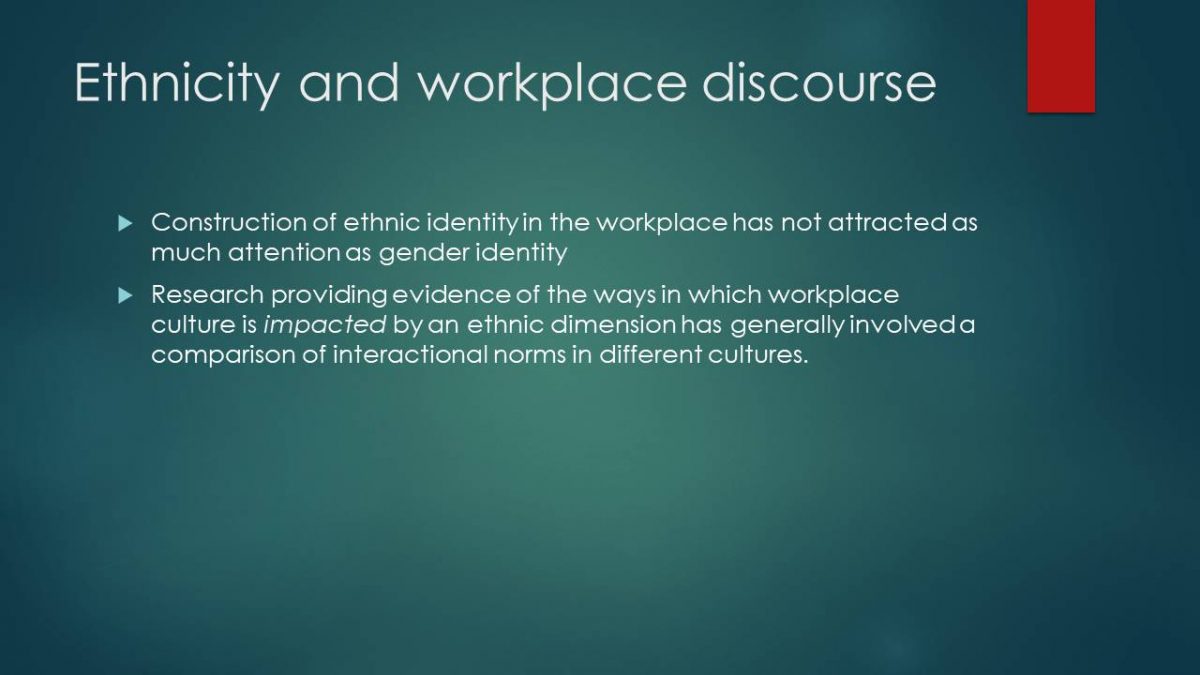
Discourse analysis on ethnicity
- Majority group discourse norms tend to go unquestioned
- Minority group norms tend to be ignored in most contexts
- Minority group norms tend to be perceived as marked if they are invoked in the presence of majority group participants
Majority group discourse norms tend to go unquestioned while minority group norms tend to be ignored in most contexts. Furthermore, minority group norms tend to be perceived as marked if they are invoked in the presence of majority group participants
Interactional norms in the majority of workplaces are typically those of the majority group, and this hegemony sometimes results in misunderstanding between majority group employers and minority group employees.
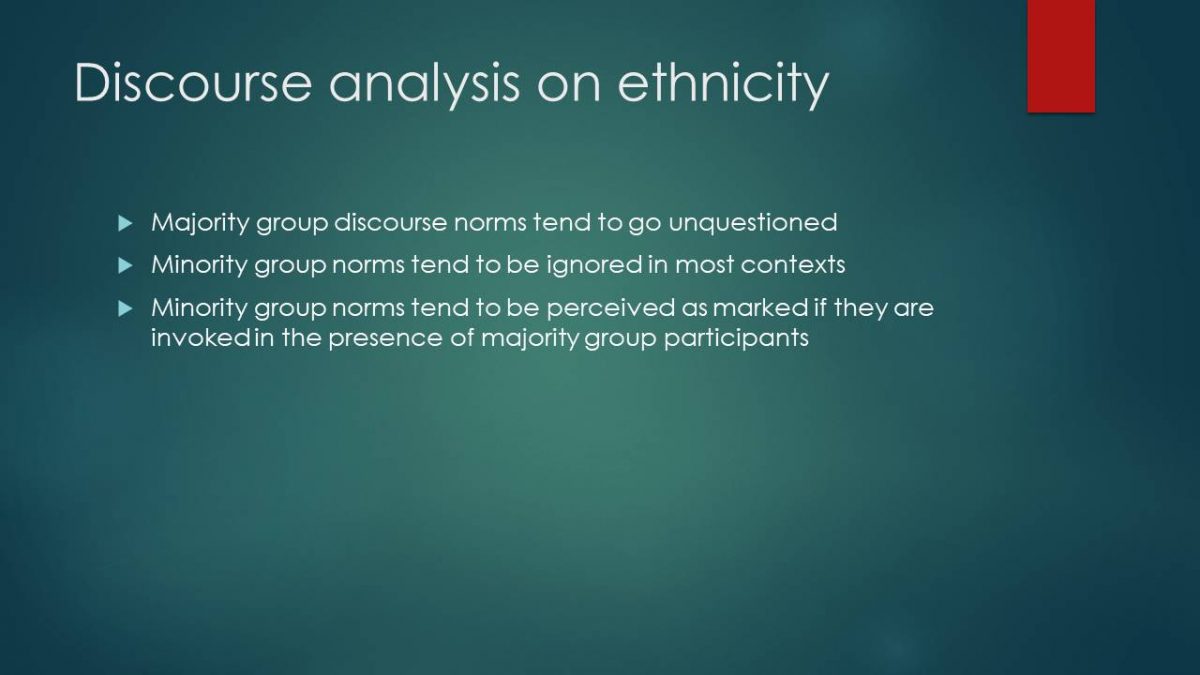
Cross-cultural and intercultural interaction and workplace discourse
- Culturally different ways of doing things at work which can result in misunderstandings in intercultural contexts
- People’s perceptions were considerably influenced by their cultural backgrounds
Culturally different ways of doing things at work which can result in misunderstandings in intercultural contexts
Significant differences between Western and Chinese participants in terms of the circumstances under which commissive speech acts are uttered, and how they are realized lexico-grammatically, with potentially detrimental consequences for intercultural relations.
Overall it is again clear that Western norms tend to prevail in most New Zealand workplace contexts.

Conclusion
In conclusion, research on workplace discourse includes both quantitative and qualitative approaches
Issues of power and control pervade all such research, from methodology through to findings, interpretation, and implications
Pre- dominant focus of workplace research to date has been white-collar, professional work- places. While, as indicated in the review above, there is some interesting research on interaction in blue-collar workplaces such as factories and building sites, this seems an area which is bound to grow, as more sophisticated techniques develop for capturing workplace discourse in noisy and less accessible work environments.
